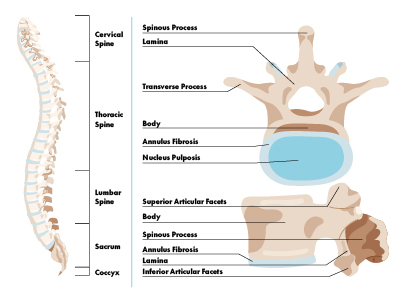Anatomy of the Spine – Upper Back, Lower Back and Neck
An inside look at the structure of the back.
 When most people mention their back, what they are actually referring to is their spine. The spine runs from the base of your skull down the length of your back, going all the way down to your pelvis. It is composed of 33 spool-shaped bones called vertebrae, each about an inch thick and stacked one upon another.
When most people mention their back, what they are actually referring to is their spine. The spine runs from the base of your skull down the length of your back, going all the way down to your pelvis. It is composed of 33 spool-shaped bones called vertebrae, each about an inch thick and stacked one upon another.
Each vertebra consists of the following parts:
The body is the largest part of the vertebrae and the part that bears the most weight.
The lamina is the lining of the hole (spinal canal) through which the spinal cord runs.
The spinous process is the bony protrusions you feel when you run your hand down your back.
The transverse processes are the pairs of protrusions on either side the vertebrae to which the back muscles attach.
The facets are two pairs of protrusions where the vertebrae connect to one another, including:
- The superior articular facets, which face upward.
- The inferior articular facets, which face downward.
The connection points between the vertebrae are referred to as the facet joints, which keep the spine aligned as it moves. Similar to other joints in the body, the facet joints are lined with a smooth membrane called the synovium, which produces a viscous fluid to lubricate the joints.
Located between the individual vertebrae, discs serve as cushions or shock absorbers between the bones. Each disc is about the size and shape of a flattened doughnut hole and consists of two parts:
- The annulus fibrosis – a strong outer cover
- The nucleus pulposis – a "jelly-like" filling.
Running through the center of the spinal column is the spinal cord, a bundle of nerve cells and fibers that transmit electrical signals back and forth between the brain and the rest of the body via 31 pairs of nerve bundles that branch off the spinal cord and exit the column between the vertebrae.
Supporting the spine, while providing it flexibility, are ligaments (tough bands of connective tissue that attach bone to bone) and muscles. Two main ligaments are:
- anterior longitudinal ligament
- posterior longitudinal ligament.
Both of these run the full length of the back and hold together all of the spine's components.
The two main muscle groups involved in back function are:
- The extensors, which include the many muscles that attach to the spine and work together to hold your back straight while enabling you to extend it.
- The flexors, which attach at your lumbar spine (lower back), and enable you to bend forward. Located at the front of your body, the flexors include your abdominal and hip muscles.
Although the spine is a continuous structure, it is often described as if it were five separate units. These units are the five different sections of the spine:
- The cervical spine – the neck and upper back, composed of the seven vertebrae closest to the skull. The cervical spine supports the weight and movement of your head and protects the nerves exiting your brain.
- The lumbar spine – the lower back, composed of five vertebrae, provides support for the majority of your body's weight.
- The thoracic spine – the middle back, made up of the 12 vertebrae in between the cervical and lumbar spine.
- The sacrum – the base of the spine that is composed of five vertebrae fused (joined together) as one solid unit. The sacrum attaches to ilium of the pelvis, forming the sacroiliac joints.
- The coccyx – the "tailbone" located below the sacrum, composed of four fused vertebrae.

Stay in the Know. Live in the Yes.
Get involved with the arthritis community. Tell us a little about yourself and, based on your interests, you’ll receive emails packed with the latest information and resources to live your best life and connect with others.


